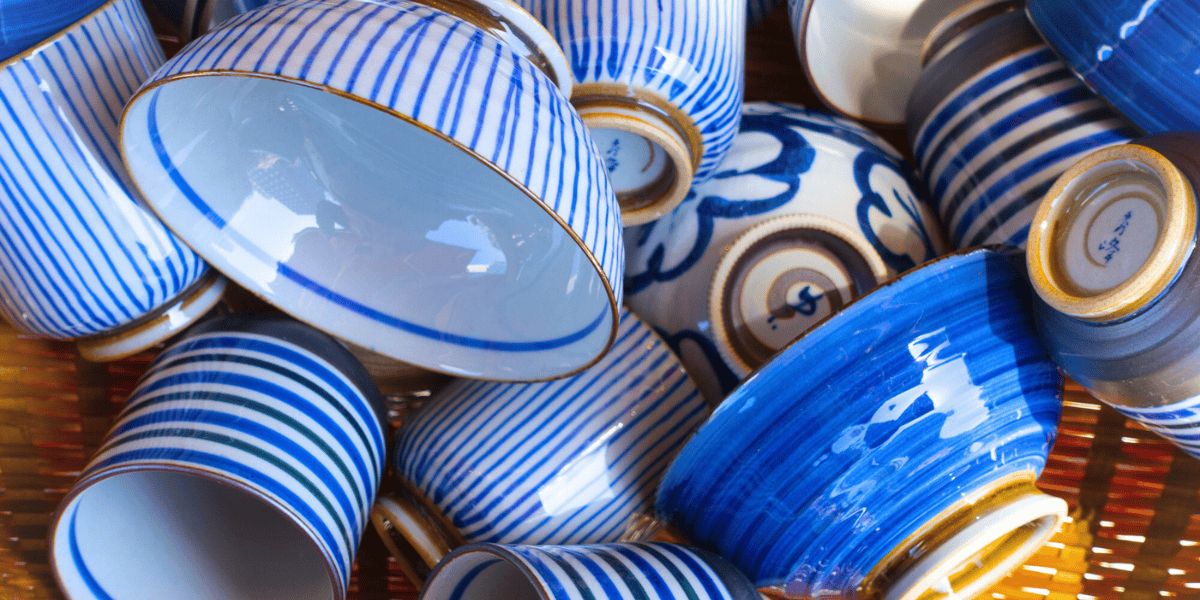Written by Brenda Goldstein
Edited by Nicki Steinberger, Ph.D.
EDITOR’S SUMMARY: Lead may feel like a problem of the past, but it continues to leach into kitchens through dishware old and new. Despite FDA limits and California’s Proposition 65 warnings, enforcement gaps leave families at risk—especially children, who are highly vulnerable to even the smallest exposures. The overview traces the history and regulation of lead in ceramics while highlighting practical steps to identify safer materials, test dishware, and push for stronger protections.
For centuries, potters used lead to give ceramic glazes their smooth shine and to intensify decorative colors in dishware and other items. Egyptians used it in pottery finishes, coins, and artifacts as far back as 4000 BC. The ancient Romans used lead in cookware, plumbing, tank linings, and water pipes. Even they recognized the dangers of contamination, linking it to madness, gout, paralysis, and premature death. An 1829 translation of a description by an anonymous hermit offers a vivid picture of the suffering it caused.
Early civilizations relied heavily on lead, but modern science has drawn a far sharper line against its dangers. The European Union, for example, has set strict limits on lead in ceramics for decades, with several member states phasing out traditional lead glazes altogether. Canada has also imposed legal limits on migratable lead and cadmium in glazed ceramic and glass foodware, reflecting a more precautionary approach to consumer health. By contrast, U.S. regulations have developed more slowly, leaving older and imported products as continuing sources of exposure.
The Cleveland Clinic lists symptoms of lead poisoning in children as cramps, hyperactivity, behavioral changes, learning problems, headaches, fatigue, and anemia. Adults may experience similar symptoms, along with decreased libido, infertility, abdominal pain, personality changes, and weakness in the feet and legs. The scope of the problem remains sobering. According to the Centers for Disease Control and Prevention (CDC), an estimated half a million U.S. children under the age of six have blood lead levels high enough to be considered unsafe. The World Health Organization states: “No safe level of lead exposure has been identified.” Even small amounts can accumulate over time, affecting brain development, behavior, and overall health.
According to the California Department of Public Health (CDPH), leaching occurs when lead passes from the glaze or decoration of dishware into the food or drink it holds—and then into your body. The degree of exposure depends on several factors: the amount of lead in the dishware, the type of glaze used, the food or drink inside, and how long it sits in the dish or cup. Acidic foods and drinks—such as salsa, citrus, soda, or coffee—can accelerate leaching. The CDPH advises against buying “highly decorative dishware from Mexico, China and other places; dishware made by small-scale artisans, especially outside the U.S.; and dishware sold by street vendors or at flea markets.”
Imports remain a significant concern. The United States brings in millions of ceramic pieces each year, many from countries with less stringent safety standards. Independent testing has repeatedly found lead levels exceeding U.S. limits in dishware imported from China, Mexico, and parts of South Asia. Because customs inspections cover only a fraction of shipments, many unsafe products still slip through to store shelves and online marketplaces.

Gaps in Regulation and Enforcement
The U.S. Food and Drug Administration (FDA) regulates Americans’ exposure to lead in food. So why hasn’t the agency removed it from dishware? The FDA has even stated: “The marketing in interstate commerce, including importation, of cookware that exhibits any level of leachable lead upon testing is prohibited.” Yet enforcement remains limited. Imported ceramics are only sporadically tested, and the FDA does not routinely screen products already on store shelves. Online sales add another layer of risk, with watchdog groups repeatedly flagging lead-containing dishes available through major platforms such as Amazon and eBay. While the agency sets standards, its ability to monitor the global supply chain and vast digital marketplaces leaves significant gaps—meaning unsafe products can still reach U.S. households. This disconnect between policy and practice has persisted for decades, even as the dangers of lead have remained clear.
Despite lead’s known health risks—including infertility, developmental disorders, muscle weakness, and high blood pressure—manufacturers continue to use lead in dish glazes well into the modern era. Even that china set passed down from your family since the Civil War may not be safe to eat on. In 1971, the FDA’s Human Food Program (HFP) began limiting leachable lead in ceramics. As of January 17, 2025, the HFP describes its purpose as to:
“Monitor products (specifically, foods and certain items that are designed for food use such as glazed ceramicware and silver-plated hollowware) that are most likely to contribute to the dietary intake of toxic elements and radionuclides (an unstable chemical element that releases radiation as it breaks down).”
Despite the HFP being in place, oversight has limits. The FDA prioritizes products considered most likely to contribute to dietary lead intake, which means many everyday items escape routine monitoring. Resources are also stretched: only select batches of ceramicware are tested, and results often depend on voluntary industry reporting. This patchwork approach leaves consumers with uneven protection, particularly when products come from smaller manufacturers or are sold through secondary markets.
The FDA’s current action‐level for lead in cups and mugs is 0.5 µg/mL (micrograms per milliliter) when new, per its pottery and ceramics guidelines; however, experts warn that lead leaching can increase as dishware ages, is worn, or becomes chipped. Public health research has shown that even very low blood lead levels (once thought safe) are associated with negative health effects in children—especially for cognition, behavior, and development. Critics say that FDA thresholds may underestimate cumulative risk from repeated, low-level exposure to lead‐glazed dishware—risk that builds over time, even if each individual exposure is within the legal limit. The Center for Environmental Health maintains that no amount of lead is acceptable:
“There’s no safe limit for lead exposure and it can affect cognitive and behavioral development in children. Lead exposure isn’t great for adults either! Lead exposure can cause weakness in the fingers, wrists, or ankles and chronic low dose lead exposure causes an increase in blood pressure.”
So how do manufacturers still get away with using lead in their glazes? In California, Proposition 65—officially the Safe Drinking Water and Toxic Enforcement Act of 1986—requires companies to warn consumers about toxic chemicals. That means dishware with a lead glaze can be sold as long as it carries a sticker stating:
“This product can expose you to chemicals including lead, which in the state of California is known to cause cancer and birth defects or other reproductive harm.”
While Prop 65 has brought more transparency, its effectiveness is debated. Skeptics argue that warning labels are so widespread in California—appearing on everything from parking garages to potato chips—that many people have become desensitized. Others counter that the law at least forces disclosure and creates a paper trail that can be used in litigation. For dishware specifically, the label may be the only red flag alerting you to a hidden hazard, though it does not reduce the actual presence of lead in the product. Seemingly minor, the warning may still help families reduce lead exposure.

Safer Choices for Today’s Kitchen
There are steps you can take to create a safer home environment. Not all pottery uses lead glazes, but beware: some makers claiming to use “lead-free” glazes may still include trace amounts, or their products may be contaminated by kilns or clay exposed to lead. Some potters use iron oxide, which provides a smooth, flawless coat without lead. But large amounts of iron oxide can leach into food, causing excess iron in the body. Iron oxide—a compound of iron and oxygen, or iron, oxygen, and hydrogen—is “generally recognized as safe” by the FDA and is widely used in makeup, pharmaceuticals, food coloring, and even pennies. Too much exposure, mainly through inhalation, can cause skin irritation and upper-respiratory distress.
For these reasons, some ceramic companies skip glazes altogether. Still, the clay itself must be carefully sourced. Secondary or tertiary clay, often cheaper, is more likely to be contaminated with lead, cadmium, or arsenic. Safer options include products made with 100 percent primary clay, dug from deeper layers free of toxins. Non-ceramic dishware—such as glass, stainless steel, bamboo, wood, or food-grade silicone—is another route. Many popular brands are FDA/Prop 65–certified lead-free and cadmium-free. The Goodlife Designs “Guide to the Safest Dinnerware Materials & Brands [2025]” offers clear explanations of different materials and their safety profiles.
Independent testing has shown that even among so-called “safe” materials, quality varies. Some stainless steel products contain nickel or other metals that may leach under certain conditions. Cheaper bamboo or melamine-based dishes may release formaldehyde when exposed to heat. Glass is generally inert, but recycled glass sometimes carries trace contaminants if not carefully processed. The safest choice is to look for makers that publish third-party testing and carry certifications under standards such as FDA compliance, California Prop 65 clearance, or international equivalents. This ensures that alternatives marketed as “lead-free” actually deliver on that promise.
If you own lead-containing dishes, wash them by hand. Dishwashers can erode glaze and decoration, increasing leachable lead and contaminating other items. You can test for lead with at-home swabs, handheld analyzers, or laboratory leach tests. Each testing method comes with trade-offs. Environmental Protection Agency–recognized 3M™ LeadCheck™ Swabs are quick and inexpensive but can produce false negatives if the lead is sealed under glaze. Handheld XRF analyzers, while accurate, are rarely accessible to the average household due to their high cost. Laboratory leach tests provide the most reliable measure of how much actually transfers into food, but they require mailing samples and waiting on results. Understanding these differences can help you decide which option fits your level of concern and resources.
A blood test for lead poisoning is low-cost and often included in pediatric care. Many doctors recommend regular screenings for little ones beginning at age one or two. Children may not show obvious symptoms—such as learning difficulties, developmental delays, or hearing loss—until long after exposure. The Mayo Clinic warns that children under six are particularly susceptible because lead can impair mental and physical development. The CDC recommends testing for kids living in homes built before 1978; youth who are immigrants, refugees, or recently adopted; those from low-income households; and those with family exposure to people working with lead.
Despite traditional “curing” methods—boiling dishes in water, soaking in lemon or vinegar, or scrubbing with bleach, garlic, and salt—none of these approaches actually remove lead from glaze or clay. The FDA outlines how to file a Citizen Petition electronically, giving you a direct path to push for stronger protections. Public pressure has influenced food and product safety policies before, from pesticide restrictions to nutrition labeling, and it can do so again. By speaking up, you can help create a safer environment—starting with the dishes in your kitchen. As Margaret Mead wisely said, “Never doubt that a small group of thoughtful, committed citizens can change the world; indeed, it’s the only thing that ever has.”
~
Published on September 18, 2025.
If you’ve found value in this article, please share it!
To support the research and health education of AVFC editorial, please consider making a donation today. Thank you.



